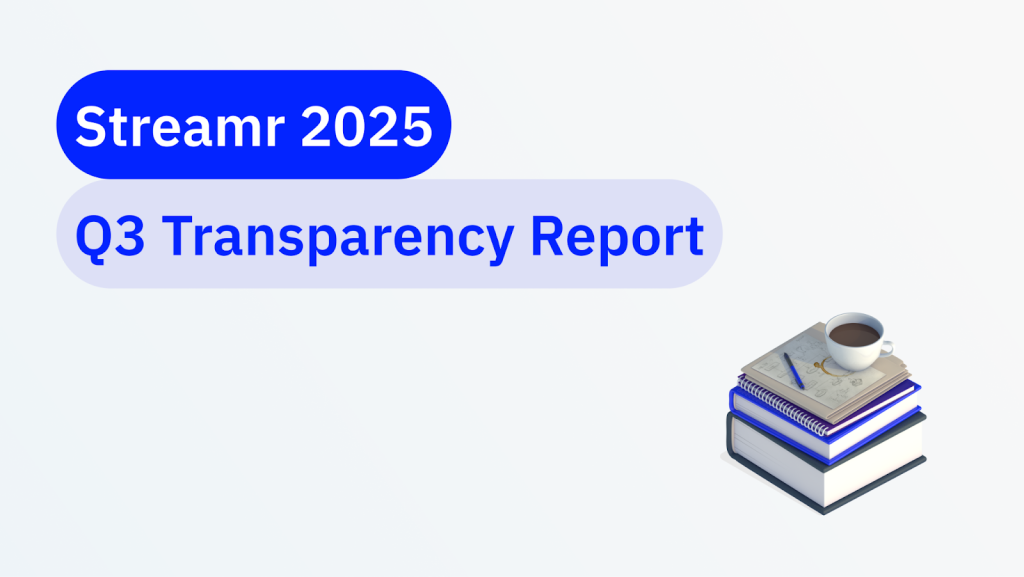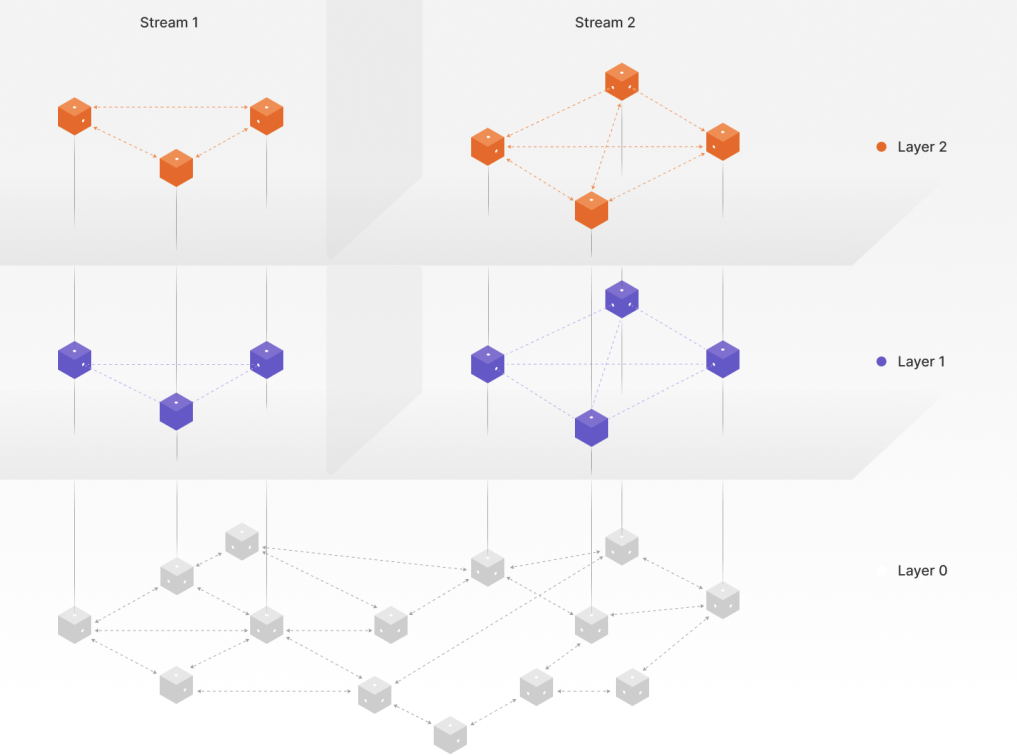With the 1.0 Mainnet milestone marking the completion of the 2017 roadmap, the Streamr team has shifted focus from R&D to full protocol adoption.
Table of Contents
TL;DR
Vote on SIP-22. Voting ends on Monday, October 28.
Our long-term goal remains clear:
To disrupt and redefine the data streaming landscape with our decentralized, peer-to-peer technology.
Achieving a feature-complete decentralized pub/sub network was no small feat:
✔️ Censorship resistant publish/subscribe messaging
✔️ Anyone can run nodes
✔️ Builder SDK and Streamr node software
✔️ Browser compatible Streamr nodes
✔️ Multi-layer DHT peer coordination & routing
✔️ Tamper-proof data with data signing & message chaining
✔️ Composable smart contract access control
✔️ End-to-end encryption
✔️ Automatic encryption key exchange
✔️ Decentralized encryption key storage
✔️ Stream partitioning
✔️ Proof of relay node inspection layer
✔️ DATA tokenomics to incentivise Operators
✔️ The Streamr Hub
The task ahead of redefining a multi-billion dollar industry with entrenched global players and decades of successful delivery of critical infrastructure with a technical paradigm shift will be an even greater undertaking. It is a journey the team believes in and is prepared for, but one we need your help to achieve.
SIP-22 and Fiscal Policy
The project expenses are currently around $230k per month. Since 1.0, as all the main tech building blocks will have been built, spending on development and maintenance has decreased, reducing costs by around half. Meanwhile, the spending allocated to growth efforts and ecosystem development is ramping up.
The Streamr DAO is voting on SIP-22, which proposes unlocking the next 100 million DATA tokens from the reserve to fund ongoing development as SIP-9 funds run out early next year. These new tokens would support adoption and key upgrades, including multi-chain deployments, a native SDK, and improved data validation.
We’d like to share an update on our current resource allocation, and the current strategic goals, to increase transparency and build trust between the core team and the community..
Current Resource Allocations:
- Marketing & business development: 33%
- Protocol development: 30%
- Technical management & leadership: 20%
- Operational costs: 10%
- Administrative support: 6%
- Legal: 1%
Medium Term Strategic Goals of the Project:
Our medium-term goals include achieving approximately 30% network usage growth, securing additional funding sources, and delivering value on high-profile use cases, such as live video broadcasting.
To achieve these goals, the project will prioritize a network configuration focused on performance over decentralization. While decentralization remains key, the Network team will shift towards delivering a fast, stable setup for paying users prioritizing serverless functionality, ease of use, cost efficiency, speed, and reliability.
Measurable Objectives
Adoption
- Increase stream sponsorship organic funding volume.
- Grow the number of nodes.
- Increase active streams.
- Boost total network message throughput.
Financial
- Diversify project funding from token minting.
- Increase the project’s fiat buffer runway.
Technical
- Deliver a “premium” network configuration that offers:
- Sub 2 second time-to-data (TTD) on average.
- Reduce outlier TTD experiences (e.g. those that exceed 10s).
- Introduced Streamr Network latency of less than 350ms on average for typical 1-to-many network topologies of under 100 nodes and reasonable data flow (a HD video for example).
- Acceptable/improved performance under adverse conditions (packet loss, handle weak nodes in topology).
- Complete the integration with IoTeX and potentially other new chains.
- Launch the native Streamr SDK.
- Offer choice for what cryptographic algorithms to use with Streamr.
- Automatic stake optimization for node runners.
We will work on producing an updated roadmap or Trello as soon as it is practical to keep you posted.
Progress on Key Adoption Vertices
Commercial adoption of the Streamr Network protocol is the key to achieving the goals set out above. This process will not necessarily be linear, it may well come with unexpected opportunities along the way, but here we can share the current areas of focus, where we are enjoying traction across a broad range of use cases.
DePIN
Streamr’s serverless, secure, and scalable framework is perfectly suited for decentralized physical infrastructure networks (DePIN). We are actively working with over 20 DePIN projects, including notable names like DIMO, Arkreen, Flux, and recently Minima following a new peer discovery use case.
The business development team has onboarded 10 projects as partners since 1.0 went live, including Functionland, Chirp, Drop Wireless, Power Pod, and Teneo Protocol, a trend that is set to continue, with more to be announced. There are also a number of exciting test cases in the pipeline exploring use cases and demos in areas such as motorsport and automotive connectivity.
Live Video
Live video is the biggest data flow on the Internet, and growing fast, but live video streaming/broadcast is also hard and expensive. By using Streamr for the last mile of video delivery, we can potentially cut down on distribution costs, and support CDNs to improve the quality of video streaming services.
This is a big opportunity if we can prove the Streamr Network is capable of CDN offloading. I.e. a cost saving technology for a large market, which could open many doors.
We are tackling the video vertical through the gateway business approach (a business that uses Streamr under the hood but presents itself as “Web2”), i.e. SubCast to build out the video player technology that can best support the Streamr Network.

Tests are ongoing to enhance the Network for video streaming, and we’re in talks with a number of video streaming companies for proof of concepts deploying Streamr for video in real-world settings.
Defense Communications
The nature of this vertical means we cannot share much about current talks and progress, but it’s understandable that P2P architecture, redundancy, interoperability, and real-time and secure messaging can offer applications in defense and security use cases—and we’re seeing some traction here.
AI
Streamr’s position with respect to AI is clear: it allows for AI models to interconnect, share insights, plug into real-time tuning data, distribute content, and collectively enhance their intelligence. AI is still emerging, and we are following industry trends to identify the killer use case for Streamr given AI’s vast data needs and calls for greater AI transparency.
Decentralized Cloud
As cloud technologies evolve, decentralized cloud networks are gaining traction, distributing data processing closer to the source. This enhances speed, efficiency, and security—aligning with Europe’s goal for greater cloud sovereignty.
Streamr can help offload content delivery networks and aggregate IoT data at the edge, supporting faster, more efficient data management. This will help bridge the gap between decentralized innovations like DePIN and Europe’s cloud sovereignty ambitions, contributing to a more resilient and independent European cloud infrastructure.
Make your Vote Count!
We hope this provides insight into our near and long-term plans, including how the 100M tokens will be allocated if SIP-22 passes on Monday. If you haven’t already, please head to Snapshot and cast your vote. And if there’s anything else you’d like to know, feel free to ask in the governance channel on Discord.











